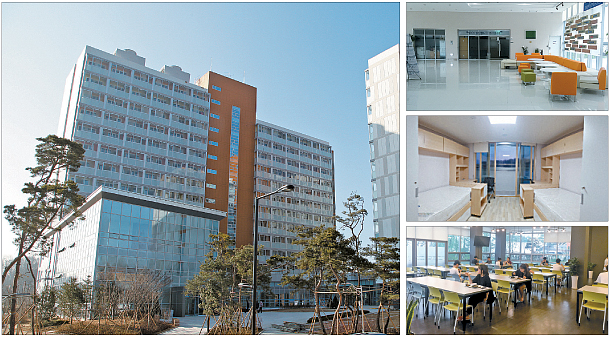Dormitory offers affordable housing for scholars

Far left: the facade of the Union Dorm in Goyang, Gyeonggi, where students from different universities live together. Inside the building is a lobby, above left, individual rooms, above right and a cafeteria, left. [KWAK JI-HYE, JANG HAE-GUN, UNION DORMITORY]
The Korea Student Aid Foundation built a union dormitory that is unlike existing dormitories for students looking for housing in Goyang, Gyeonggi. Unlike dorms provided by universities, The Union Dorm accepts students from different institutions. University students in Korea usually live at their school’s dormitory, which are quite expensive, but The Union Dorm’s boarding fees are half the price. Therefore, it is popular among students and highly competitive.
The Korea Student Aid Foundation provides student loans and scholarship programs to help students study regardless of their financial circumstances and create a study environment that contributes to fostering talent needed in the nation.
According to an investigation of residence conditions of university students by the Young People’s Council, among the 2.18 million university students in the nation, about 40 percent have to leave home and find housing close to their school.
According to the Korea Student Aid Foundation, the government and private organizations are worried about the poor housing environment for university students and higher cost of housing, but often take a long time to come up with a solution. The burden of figuring out an answer to the problem has fallen on the students, who came up with the concept of creating union dorms outside of universities. The union dorm created by the Korea Student Aid Foundation was given support land from the government, and received donations of up to 326 billion won ($290.8 million) from the Bank Association and 20 member companies.
The chairman of the board of The Korea Student Aid Foundation Ahn Yang Ok said, “I expect this to be the first step in solving the problems of university students.”
Living in the Dormitory
At the Korean Student Aid Foundation, what is the biggest difference between the university dormitory and the Union dorm? “The foundation’s dormitory is built outside of the university, not in the university so students from different universities can live together.”
Rent at the Union Dormitory is 150,000 won per month without any additional operating expenses. The Union Dormitory uses the profits from the boarding expenses, excluding operation and repair expenses, to support student welfare projects. Welfare projects are mainly used to support students’ education programs and club activities. Additionally, a special lecture by MBC producer Kim Min-sik was held at the dorm. The dormitory also allows students to use the building’s facilities for club activities and other extracurricular events.
One of the other strengths of the dormitory is autonomy. “Most university dormitories have a curfew at 10 p.m., but the Union Dormitory’s curfew is at 1 a.m. I’m free,” said Jeong Tae-Hyun, who lives in a dormitory.
There are students from across the Seoul Metropolitan Area, including Agricultural Cooperative University, Myongji University and Korea Aerospace University. As many students from various universities board in the Union Dormitory, they are working hard on building a self-sustaining community. Although the Union Dormitory was not able to organize a student council immediately after Union Dormitory opened in March 2017, the students are now preparing to elect a president of the student council for the second half of the school year. Currently, each floor has a “Floor Leader” and communications are announced and spread through these leaders.
Although there are many freedoms to living in the Union Dormitory, the students work together to enforce and ensure that the rules and regulations of the dorm are being adhered to. In order to ensure that students comply with these rules, a punishment point system has been created and if a student racks up over 15 penalty points, they may be asked to leave the dormitory.
“There is nothing terribly uncomfortable about living in a Union Dormitory. However, it is difficult to find a mart because of the lack of infrastructure around nearby, so life is a little inconvenient. And I requested to install an ATM, but it’s not installed yet,” Jeong Tae-hyun said.
To solve the problems
The Happy Dormitory is another university housing project built using public funds from the Korea Foundation for the Promotion of Private & Public Schools. The organization has a dormitory in Hongje-dong, western Seoul, which can accommodate 516 people, and also in Busan, which can accommodate 1,500 people.
The organization is working to open another Happy Dormitory which can accommodate 750 people in Dongsomun-dong, central Seoul, but opposition from local residents is delaying the construction.
To work with the demands of the residents in the area, the Korea Student Aid Foundation has formed a space that connects the Union Dormitory with the community. It hopes to meet the needs of local residents by creating an educational space and social contribution programs such as talent donation, mentoring, financial consultation, volunteer activities and an open library that can be used by both students and local residents.
The Korea Student Aid Foundation is preparing for the establishment of an additional Union Dormitory to ease the burden of housing for college students. In addition, the Korea Student Aid Foundation said that it is examining the space for supporting cultural activities, discussions and career counseling for university students.
“The Union Dormitory is relatively inexpensive and close to the university. In a nutshell, it is the best. I hope similar dormitories will be built in the future,” Jeong said.
BY KWAK JI-HYE, JANG HEA-GUN [jihye9633@naver.com, stioic1532@naver.com]










with the Korea JoongAng Daily
To write comments, please log in to one of the accounts.
Standards Board Policy (0/250자)